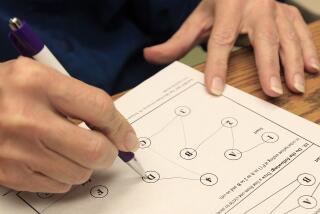MEDICINE / ALZHEIMER’S DISEASE : Eye Drug Has Promise for Early Detection
Using a drug commonly employed to detect cataracts during eye examinations, Harvard researchers have devised an inexpensive new test for Alzheimer’s disease that promises to speed the identification of the hard-to-diagnose disorder.
Alzheimer’s, which causes loss of memory and bodily control and is eventually fatal, affects as many as 4 million Americans--including former President Ronald Reagan, who announced Saturday that he is in the early stages of the disease.
Researchers are enthusiastic about the new technique, whose discovery is reported today in the journal Science. But they caution that it has been studied in only a small number of people and must be tested on a much larger scale.
That caution, some experts argue, is justified. At least three other highly touted tests for the disorder failed to live up to their preliminary promise when tested in larger trials.
Neurologists are desperate for a simple way to diagnose Alzheimer’s in its earliest stages, or even before symptoms appear. They believe several drugs now in development could delay progression of the disorder if they were given early enough.
“While this is certainly an exciting finding, we have to do more research to confirm these results and see if the test is reliable for Alzheimer’s disease,” said Dr. Steven DeKosky of the University of Pittsburgh, a member of the Alzheimer’s Assn. advisory board. If it does work, “It would be marvelous,” added Dr. Leon Thal of UC San Diego.
The cause of Alzheimer’s is unknown, but it is closely tied to aging. One in 10 people over age 65 have the disease and nearly half of those over 85 are afflicted, suffering severe memory loss, an inability to think clearly, a short attention span and accelerated physical deterioration. Care for Americans with the disorder costs an estimated $80 billion per year, according to the Alzheimer’s Assn.
There is currently no easy way to diagnose Alzheimer’s. Patients such as Reagan are diagnosed with a battery of blood tests, a physical examination, magnetic resonance imaging and sophisticated neuro-psychological tests that rule out all other sources of symptoms. But these tests may cost thousands of dollars and are wrong 25% to 40% of the time, according to neuroscientist Leonard F. M. Scinto of Harvard Medical School.
Scinto’s colleague, neuroscientist Huntington Potter of Harvard, got the idea for the new test from his work with Down’s syndrome, whose victims share many symptoms and biological problems with Alzheimer’s patients. Down’s patients who survive past age 30 develop brain lesions virtually identical to those of Alzheimer’s patients and also display most of the characteristic mental problems.
Down’s patients are known to be unusually sensitive to a class of drugs that inhibit transmission of signals between brain cells by a neurotransmitter called acetylcholine. This hypersensitivity is detected by a change in heart rate or an increase in pupil size after administration of such drugs. The response to these drugs had apparently never been studied in Alzheimer’s patients, however.
Scinto’s team used the drug tropicamide, settling on a dose 1/100 of that used to dilate pupils during an eye examination. They found that placing a drop of this solution in the eye caused the pupils of Alzheimer’s patients to dilate by 13% or more within 30 minutes, while those of healthy individuals dilated an average of only 4%. The dilation disappears within an hour or two.
They then examined 58 elderly individuals, including 19 with early symptoms or a formal diagnosis of Alzheimer’s. Eighteen of the 19 showed the increased dilation. One of those had no obvious mental problems and only a mild difficulty with daily living activities. Within nine months, however, he had developed marked cognitive problems and memory loss, indicating that the test may be able to diagnose Alzheimer’s very early in the course of the disease.
Among the remaining healthy patients, only two showed a positive response to the test. The researchers are monitoring their progress to see if they also develop the disorder.
The researchers said that hundreds, perhaps thousands, of other subjects need to be tested before they are confident that procedure successfully identifies the disease, a process that will take at least two years. They also noted that the test presently cannot be conducted by most ophthalmologists because special equipment is necessary to measure the change in pupil size.
(Southland Edition, A24) Test for Alzheimer’s
Alzheimer’s disease can currently be diagnosed only with a complete battery of blood, clinical and psychological tests, and even then the diagnosis is only 75% accurate, at best. Here is a look at a new test that promises to be 95% accurate.
* Researchers put a drop of a diluted solution of the drug tropicamide in the eye.
* A sophisticated instrument is used to measure dilation of the pupil.
* If the pupil dilates 13% or more within 30 minutes, the patient has Alzheimer’s. If it doesn’t, the patient is healthy.






